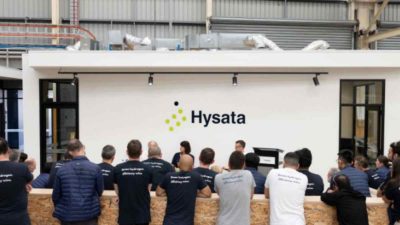Australian startup Hysata has raised $111 million from investors during its Series B financing round, which has the potential to “redefine the economics of green hydrogen production.”
Hysata has described it as a “move the needle” investment and a “knock it out of the park” moment for the company.
Why does this matter? It could reduce the cost of clean-burning fuel significantly. The startup believes it has the right plans to make it cheaper, which is needed for emission-free hydrogen to be adopted globally.
CEO Paul Barrett says this will help to fast-track Hysata’s plans to have their first “commercial electrolyzer units globally.” He recognizes that this funding is significant not only for the company. “The real measure of success is not the amount raised, but how we use it to make a difference.”
Hysata’s Series B funding round
The Series B round was co-led by BP and Templewater. Together with the existing investors, Hysata says they all share the same vision of “accelerating the decarbonization of hard-to-abate sectors.”
Barrett says this is a team effort, which excites him about how the industry pulls together. “Hysata’s technology is a game-changer, and nothing comes close to performance or cost. Our high-efficiency electrolyzer (41.5 kWh/kg incl BoP) has intrinsically low capex and a capital-efficient path to mass manufacturing.”
Producing the lowest green hydrogen
Hysata’s goal is to be a trailblazer for green hydrogen. Barrett says they want to be the “world-first electrolyzer performance that will produce the lowest cost green hydrogen.”
According to Bloomberg, Hysata’s electrolyzer technology is highly energy efficient, converting 95% of electricity into hydrogen without creating bubbles. Standard electrolyzers convert about 75% of electricity into hydrogen.
It’s reported that the other 25% gets lost due to bubbles, which cause water to lose contact with metal. But Hysata believes they managed to avoid the bubbles.
ALSO READ: FedEx Express tests hydrogen-powered technology
As Bloomberg reports, the team of researchers found using a property of water to bypass bubbles. When in liquid form, it rises against the force of gravity. To put this in perspective, it’s one of the forces trees use to extract water from the soil upwards to the rest of the tree.
2024 the year of hydrogen
This year is shaping into a defining moment for the hydrogen industry. This year is seen as a significant step in the global energy transition.
Despite this, some experts believe policies are still not in place to make this transition as smooth as possible.
Murray Douglas, vice president of hydrogen and ammonia research at Wood Mackenzie, says the initial strategies published by Japan about a year ago and South Korea in 2022 state the opposite. “Lack [of] clarity on subsidy scheme and emissions thresholds.”
Transition costs pose a major challenge, alongside dwindling government funding for hydrogen projects.
NOW READ: Unlocking hydrogen’s potential: Trends to watch in 2024
Photo credit: Hysata LinkedIn
About the author
Mia is a multi-award-winning journalist. She has more than 14 years of experience in mainstream media. She's covered many historic moments that happened in Africa and internationally. She has a strong focus on human interest stories, to bring her readers and viewers closer to the topics at hand.











